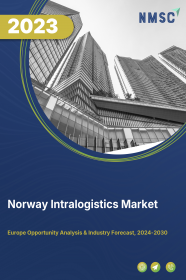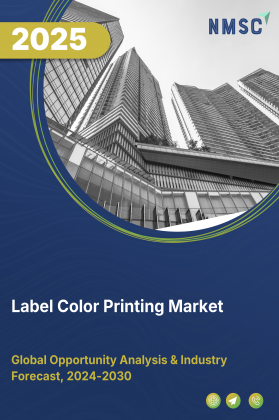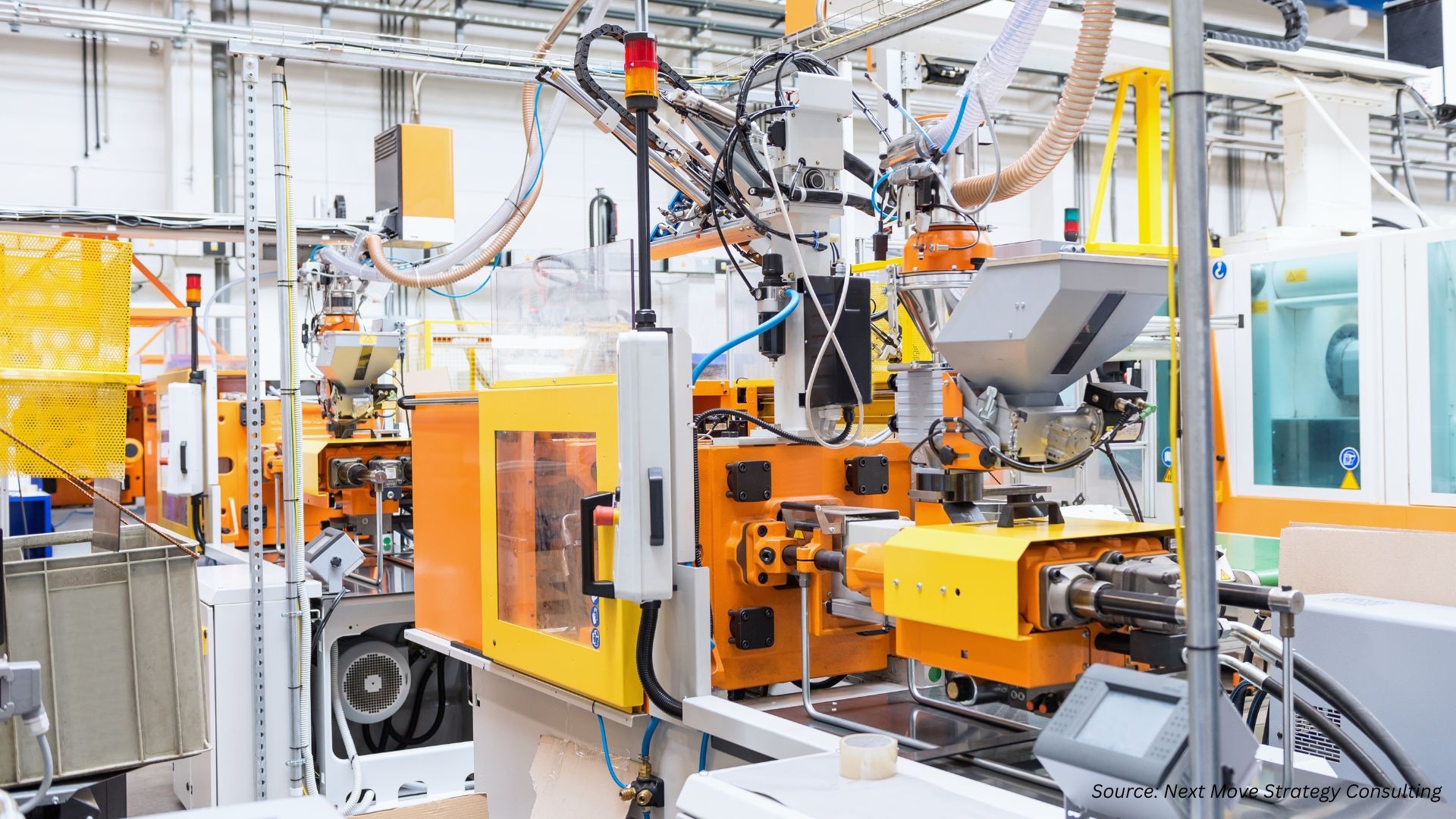
Norway Intralogistics Market by Component (Hardware, Software, and Services), by Automation Level (Manual, Semi-Automated, and Fully Automated) , by End User (Retail and E-commerce, Automotive, Food and Beverage, Pharmaceuticals, Aviation, Logistics, Semiconductor & Electronics, Consumer Goods, and Other End Users) – Opportunity Analysis and Industry Forecast 2023–2030.
Industry: Construction & Manufacturing | Publish Date: 30-Aug-2025 | No of Pages: 74 | No. of Tables: 122 | No. of Figures: 67 | Format: PDF | Report Code : CM1052
Market Definition
Norway Intralogistics Market was valued at USD 397.05 million in 2022, and is predicted to reach USD 1091.1 million by 2030, with a CAGR of 13.4% from 2023 to 2030. Intralogistics is a vital aspect of supply chain management, and its market is focused on the design, implementation, and maintenance of internal logistics systems. In order to maximise the flow of materials and effectively and economically meet the company's demands, it entails the movement, storage, and management of commodities within an organisation, such as a factory, warehouse, or distribution centre.
The intralogistics market involves the design, implementation, and maintenance of factory and warehouse systems and includes various industries such as manufacturing, retail, e-commerce, and healthcare. Material handling, inventory control, order fulfilment, and reverse logistics are some of the most frequent applications of intralogistics. The intralogistics industry is expanding as a result of rising need for quick and effective delivery, rising demand for automation, and rising demand for sustainable and environmentally friendly solutions.
Green Robotics Revolution Fuels Norway’s Sustainable Intralogistics Market
The growing demand for eco-efficient automation is reshaping Norway’s intralogistics sector, with a strong national focus on reducing emissions and advancing environmental goals. Companies across Norway are increasingly adopting green robotics and energy-efficient automation systems that align with climate policies under programs like Enova SF and Grønn Plattform. Technologies such as electric autonomous mobile robots (AMRs), solar-powered warehouse equipment, and low-emission conveyor systems are being prioritized to meet both regulatory requirements and internal ESG (Environmental, Social, and Governance) targets.
Norwegian logistics providers and manufacturers are not only investing in automation for operational efficiency but are also strategically aligning these efforts with broader sustainability commitments. Local innovators and global players are collaborating to create solutions that reduce energy consumption, minimize waste, and support circular economy models. As the push for carbon neutrality gains momentum, the integration of sustainable robotics has emerged as a defining trend, positioning Norway as a leader in green intralogistics innovation within Europe.
Norway’s Drive for Operational Excellence Spurs Advanced Intralogistics Adoption
In today’s highly competitive and digitally connected market, Norwegian businesses are under increasing pressure to deliver faster, more accurate, and more resilient supply chain operations. With rising e-commerce volumes, global trade complexities, and customer expectations for rapid fulfillment, the need for streamlined, responsive intralogistics systems have become more urgent than ever. Norwegian companies are responding by deploying advanced technologies such as AI-powered warehouse management systems (WMS), real-time inventory tracking, and predictive analytics to ensure seamless internal logistics.
These innovations not only reduce operational costs but also enhance agility and scalability in supply chain management—factors critical to maintaining a competitive edge. From micro-fulfillment centers in Oslo to automated cold chain hubs in Tromsø, Norwegian enterprises are leveraging modular AS/RS systems, robotic picking solutions, and IoT-enabled platforms to boost productivity. The national push toward Industry 4.0 and participation in EU Horizon programs further supports this digital transformation, positioning intralogistics excellence as a strategic cornerstone of Norway’s industrial and commercial success.
High Installation Costs Pose a Challenge to Norway’s Intralogistics Market Growth
The significant upfront investment required for intralogistics systems remains a major challenge in the Norwegian market, particularly for small and medium-sized enterprises (SMEs). Implementing solutions such as AS/RS, autonomous mobile robots (AMRs), and advanced WMS platforms demands substantial capital for equipment, system integration, software licensing, and ongoing maintenance. These costs are further amplified when customized configurations or retrofitting existing facilities are involved—factors common in Norway’s space-constrained urban warehouses.
While large corporations and third-party logistics (3PL) providers can absorb these costs due to their scale, many SMEs face difficulty justifying the return on investment, especially in industries with thin margins. The high financial barrier often drives smaller players to adopt manual or semi-automated alternatives, which can reduce overall market penetration for fully automated intralogistics solutions. Without broader access to financing, subsidies, or scalable low-cost automation models, this cost challenge may continue to dampen the full potential of Norway’s otherwise progressive and innovation-ready intralogistics ecosystem.
Unlocking Opportunities: Drone Integration Set to Transform Norway’s Intralogistics Market
The integration of drones, or unmanned aerial vehicles (UAVs), into Norway’s intralogistics landscape presents a promising frontier for innovation and efficiency. As businesses increasingly prioritize real-time visibility and agile operations, drones are being piloted for a variety of tasks such as automated inventory checks, internal order picking, and rapid material transport within large warehouse environments. Their ability to access hard-to-reach storage areas significantly reduces dependency on manual labor, ladders, and lifts—enhancing both safety and operational speed.
Norwegian companies are also beginning to explore drone-enabled data collection, leveraging built-in sensors and cameras to monitor inventory levels, detect damage, and track SKU movements. This real-time data can feed into AI-powered WMS platforms to improve forecasting accuracy, reduce waste, and optimize picking routes. As regulatory frameworks evolve to accommodate aerial automation and drone technologies become more cost-effective, their adoption is expected to rise—particularly in high-value industries such as pharmaceuticals, electronics, and maritime logistics. These advancements are poised to open new growth avenues and elevate Norway’s intralogistics capabilities to the next level of automation and intelligence.
Competitive Landscape
The Norway intralogistics industry includes several market players such as AutoStore Systems, Jungheinrich AG, SSI Schafer, Roket Fram AS, Honeywell International Inc., Vanderlande Industries B.V., Schmersal, Inc., Elements Logic, Siemens AG, Bowe Intralogistics, KNAPP , Swisslog , STILL GmbH, MasterMover, and Locus Robotics
Key Benefits
-
The Norway intralogistics market report provides a quantitative analysis of the current market and estimations through 2023-2030 that assists in identifying the prevailing market opportunities to capitalize on.
-
The study comprises a deep dive analysis of the market trend including the current and future trends for depicting the prevalent investment pockets in the market.
-
The information related to key drivers, restraints, and opportunities and their impact on the market is provided in the report.
-
The competitive analysis of the market players along with their market share in the Norway intralogistics market.
-
The SWOT analysis and Porter’s Five Forces model are elaborated in the study.
-
Value chain analysis in the market study provides a clear picture of the stakeholders’ roles.
Norway Intralogistics Market Key Segments
By Component
-
Hardware
-
Automated Storage & Retrieval Systems (AS/RS)
-
Unit-Load AS/RS
-
Mini-Load AS/RS
-
Vertical Lift Modules (VLMs)
-
Carousel AS/RS
-
-
Conveyors Systems
-
Vertical Lift Modules
-
Forklifts
-
Pallet Jacks & Stackers
-
Shuttle Systems
-
Industrial Robots
-
Mobile Robots
-
Automated Guided Vehicles (AGVs)
-
Autonomous Mobile Robot (AMR)
-
-
-
Software
-
Warehouse Management System (WMS)
-
Transportation Management System (TMS)
-
Yard Management Software
-
Inventory Management Software
-
Labor Management Software
-
Other Software
-
-
Services
By Automation Level
-
Manual
-
Semi-Automated
-
Fully Automated
By End User
-
Retail and E-commerce
-
Automotive
-
Food and Beverage
-
Pharmaceuticals
-
Aviation
-
Logistics
-
Semiconductor & Electronics
-
Consumer Goods
-
Other End Users
KEY PLAYERS
-
AutoStore Systems
-
Jungheinrich AG
-
SSI Schafer
-
Roket Fram AS
-
Honeywell International Inc.
-
Vanderlande Industries B.V.
-
Schmersal, Inc.
-
Elements Logic
-
Siemens AG
-
Bowe Intralogistics
-
KNAPP
-
Swisslog
-
STILL GmbH
-
MasterMover
-
Locus Robotics
REPORT SCOPE AND SEGMENTATION:
|
Parameters |
Details |
|
Market Size in 2022 |
USD 397.05 Million |
|
Revenue Forecast in 2030 |
USD 1091.1 Million |
|
Growth Rate |
CAGR of 13.4% from 2023 to 2030 |
|
Analysis Period |
2022–2030 |
|
Base Year Considered |
2022 |
|
Forecast Period |
2023–2030 |
|
Market Size Estimation |
Million (USD) |
|
Growth Factors |
|
|
Companies Profiled |
15 |
|
Market Share |
Available for 10 companies |
|
Customization Scope |
Free customization (equivalent up to 80 working hours of analysts) after purchase. Addition or alteration to country, regional, and segment scope. |
|
Pricing and Purchase Options |
Avail customized purchase options to meet your exact research needs. |

















 Speak to Our Analyst
Speak to Our Analyst
























